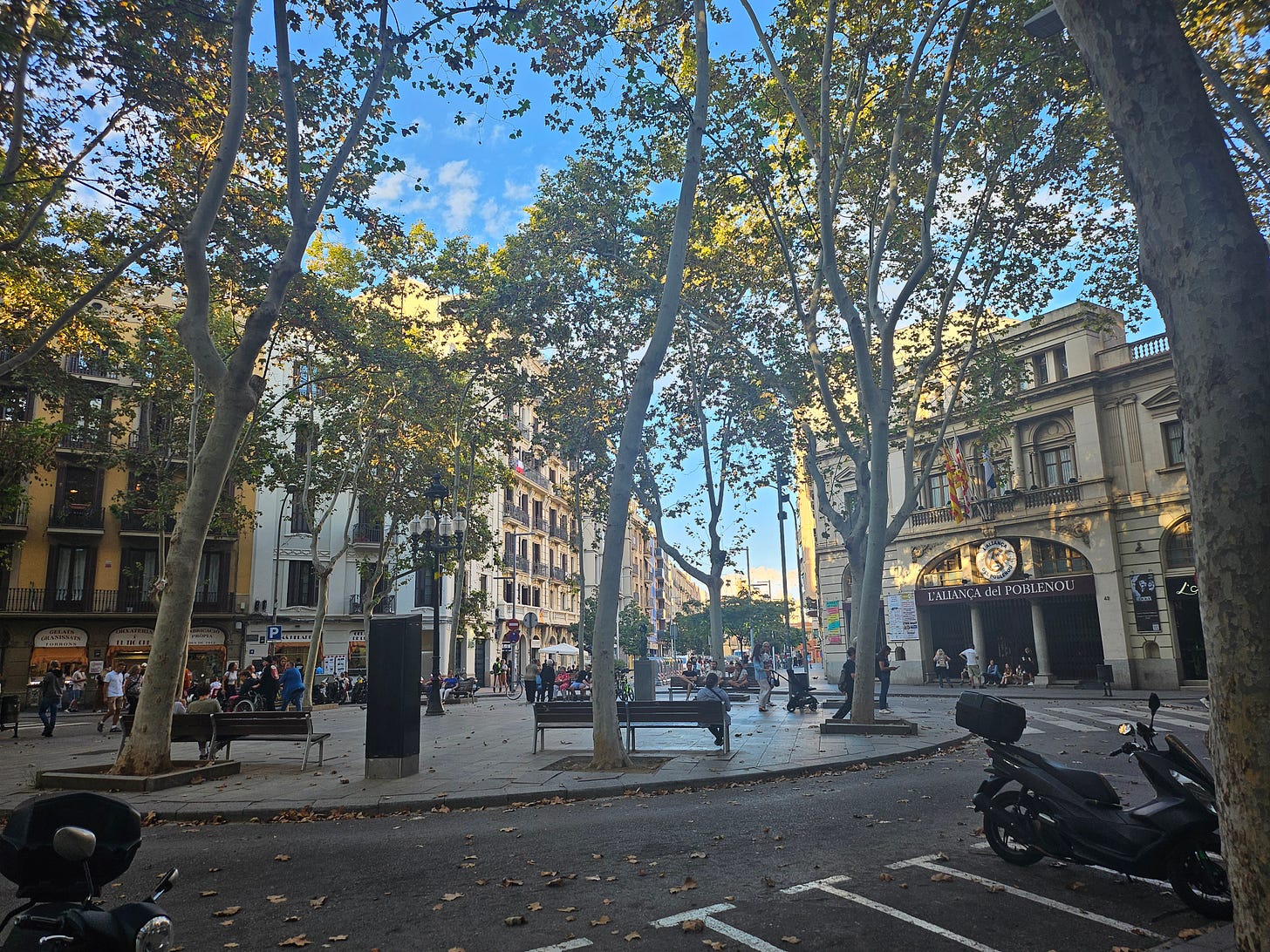Experiencing Barcelona's Superblocks
An innovative urban design for a more livable city, inspiring the world to prioritize human well-being and build climate change resiliency.
Visiting Barcelona for a couple months this fall, I’ve been taking in the city and appreciating the local way of life: walking along expansive pedestrianized streets, people of all ages enjoying the warm weather in dedicated public squares, a mix of bikers and scooters cruising along in lanes separated from car traffic, and generally feeling safer from cars compared to what I’m used to in Toronto.
These are all part of the Superblock model, which is redefining urban planning in the city. This people-first approach supports sustainable public transportation and reorganizes public space, resulting in reduced noise pollution, improved air quality, and increased social interaction.
How exactly do they work? Essentially, a set of streets are closed off around a set of blocks (typically 3 by 3) from the existing infrastructure, such that car traffic is diverted around it, or in some cases reduced to speeds as low as 10km per hour. The inner streets are then reclaimed and renewed, transformed into an island of pedestrian-priority zones consisting of elements like greenery, parks, street furniture, playgrounds, and room for various local community use.

Barcelona's Urban Legacy
Barcelona is renowned for its innovative approach to urban planning. The Superblock concept is the latest evolution in this tradition, building on a foundation laid in the 19th century by Ildefons Cerdà. Cerdà, a pioneering Spanish urban planner, coined the term "urbanization" in his 1867 "General Theory of Urbanization," which detailed the science of making cities and strived to balance the best parts of rural and urban living.
His design for the Eixample district (Catalan for 'Expansion') served as a model for future urban development; over a century later, Salvador Rueda, head of Barcelona’s Urban Ecology Agency, expanded on the blueprint of the city 'block' to create the Superblock model.
Although Superblock planning and small pilot projects started in the 1980’s, the project began in earnest in 2016 in the neighbourhood of Poblenou. This initiative was motivated by the need to address several interconnected urban challenges, driven by the city’s overreliance on cars.
This car dependency contributed to an overcrowded city centre, excessive air pollution exceeding EU limits, high noise levels, and a lack of green spaces that exacerbated urban heat island effects. These environmental and health concerns are especially urgent now, as recent years have seen back-to-back record-breaking summer temperatures (2022, 2023, 2024).
Balancing Progress and Concerns
Implementing Superblocks has not been without its difficulties. The initiative had faced pushback from community members worried about a range of potential consequences, including negative impacts on local businesses due to reduced car traffic, disruptions to public transit routes, and the possibility of increased social inequalities. This resistance is especially pertinent to Barcelona with its strong anti-tourist sentiment and gentrification concerns more recently.
In the political arena, the implementation had been framed by some as a radical left-wing policy championed by the former mayor, Ada Colau, who faced a series of legal challenges from prominent retailers and stakeholders in the tourism industry seeking to reverse pedestrianization efforts. The transition to the new mayor, Jaume Collboni, who took over in 2023, could mark a period of uncertainty. A more reserved approach to Superblock expansion could be taken for the sake of political posturing, potentially affecting the pace and extent of future implementation.
Despite these hurdles, Barcelona remains committed to its ambitious goal of installing 503 Superblocks by 2030 as significant benefits are realized by the community, where a 24% reduction in air pollution levels is estimated to prevent 700 premature deaths and generate economic savings of 1.7 billion euros each year.
A Global Inspiration: Superblocks Reshaping Cities Worldwide
Barcelona's Superblocks have become a source of inspiration for cities worldwide seeking to create more sustainable and resilient urban environments to address current and future climate change issues. In 2022, over 250 cities sought information about implementing Superblocks, demonstrating a growing universal interest in this innovative urban solution for a common vision of the future - greener, less polluted, and more livable cities.
Architects and city planners are praising the model for its flexibility, noting its potential to be integrated into both grid-oriented cities and those with more unique layouts. Some notable examples around the world include:
Vitoria-Gasteiz, Spain: The capital city of the Basque Country in northern Spain, not too far from Barcelona, is one of many Spanish cities implementing “Super-manzanas” (Spanish for “Super Apples”), complemented by a comprehensive Green Urban Infrastructure strategy to prepare for increased precipitation and flood risks.
Berlin, Germany: Directly inspired by Superblocks, the city has over 50 ‘Kiezblocks’ (German for “Neighbourhood Blocks”) initiatives, each customised in their implementation to address increasing amounts of traffic that are contributing to high noise and air pollution, along with the dangers for children and the elderly.
Los Angeles, USA: One of the originators of car-dependent urban design in the 20th century, is now embracing Superblock principles, a particularly noteworthy shift. The “Park Block” program was introduced in 2023 as a way to tackle poor air quality and particularly high pedestrian casualties represented by over 312 people killed in traffic collisions in 2022.
Buenos Aires, Argentina: This capital city has been aiming to reduce its carbon footprint and increasing its citizen quality of life through prioritizing public transportation, cycling, and pedestrian walking - today, a majority of its downtown core is car-free consisting of “Macromanzanas”, inspired by Superblocks.




